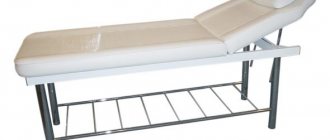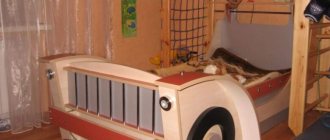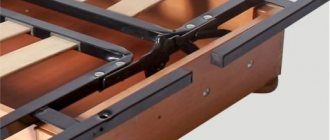If, for example, household appliances become unusable, it is often easier to replace them than to repair them. If the external component of the furniture has become unusable, then there is a chance to update it without the most difficult and costly means. In most cases, it is enough to change the upholstery to restore the appearance and properties of all furniture. In the article we will tell you how to reupholster a sofa yourself, how to choose the right materials and filling, describe the features of this process and give step-by-step instructions for reupholstering.
Advantages of reupholstering a sofa with your own hands
It is better to reupholster a sofa with a high-quality base than to replace it with a modern analogue. Whatever one may say, very reliable mechanisms used to be made that could serve the owner and his children/grandchildren for many years.
Obvious bonuses of self-upholstery:
- Unlimited design. You do everything yourself, and therefore you can easily choose any elements solely to your taste. Color, material, armrests, other details - you choose all this.
- Possibility to repair internal elements. In addition to the constriction itself, it is possible to level out the shortcomings of the frame or spring block that have formed over the years of use. Saving money. When you have the opportunity to reupholster the sofa yourself, you save money, because new furniture will cost more in any case.
- Preservation of your favorite corner. There is no need to throw a comfortable sofa that satisfies all parameters into a landfill - just follow all the recommendations for step-by-step reupholstery.
Selection of materials
Before you reupholster the sofa yourself, you need to decide what materials you will use. This applies primarily to upholstery and filling.
Filler
- Polyurethane foam is a synthetic foam structure that can vary in degree of rigidity, but generally adapt to the shape of the body during rest. Inexpensive types of filler lose their shape over time.
- Synthetic winterizer is usually combined with other materials, for example, polyurethane foam. This is all due to its insufficient rigidity - it is easily pressed, and therefore, over time, sleeping exclusively on padding polyester becomes uncomfortable. In its pure form it is more suitable for pillows than as a sofa filler.
- Struttofiber, which is also called “non-woven independent springs”. The material follows the anatomical features of the user, is resistant to moisture, breathable, and hypoallergenic.
- High-density felt is a natural felted version of the filler. It is not used in its pure form, but only in combination with other materials. It has good hypoallergenic and thermoregulatory properties. Requires careful care to prevent the appearance of mold and insects.
- Foam rubber is considered the most inexpensive and accessible filler, but over time it crumbles. Well suited for filling armrests or furniture completely, provided it is used infrequently.
Advice. To fill a sofa, it is best to combine several materials. A good option is struttofiber + felt + polyurethane foam.
Upholstery materials
- The velor has a velvety and slightly shiny appearance. It is easy to wash and vacuum clean. The material is well ventilated, quite durable and soft.
- Flock is chosen by those who have pets. All because of its resistance to claws, easy washing, hypoallergenicity. Well suited for upholstering furniture for children.
- Jacquard emphasizes the luxury of the product. Yes, upholstery is more expensive, but it allows you to get a magnificent appearance of the product. You should be careful when caring: do not use aggressive detergents or acids, protect the sofa from direct sunlight.
- Natural tapestry with a three-dimensional pattern on the surface is highly durable, easy to clean, and pleasant to the touch.
- Leather is not the most practical upholstery option and is more suitable for office sofas or furniture that is used infrequently and is more of an interior item than a full-fledged sleeping place.
- Scotchgard is considered a modern upholstery option. Any design can be applied to it - it is the originality of the material that is highly valued by users. Easy to wash, but as durable as bed linen (washing - no more than 40 degrees). The material is often used as a cape.
Advice. One of the most important conditions for the durability of a sofa is the quality of the upholstery. Therefore, when choosing, consider not only the price of the material, but also the conditions of use: frequency, presence of children and pets.
When to contact specialists
It is not always possible to replace the upholstery of a sofa with your own hands - in many cases this requires experience and skill. It is better to know in advance in which cases it is advisable to turn to professionals :
- the piece of furniture is a complex structure, which will lead to assembly problems;
- the upholstery itself is quite complex - it has many different structural elements, because you will have to repeat each of them, which is almost impossible in the absence of experience in sewing;
- the old upholstery of the sofa is very worn out - most likely, both the filling and the springs will have to be replaced, which requires specific knowledge and experience;
- the sofa is too expensive - you must admit, it would be a shame to spoil an expensive thing, because you will then have to buy it again;
- It was decided to upholster the sofa with genuine leather or eco-leather.
It is quite possible to replace the upholstery of a sofa with your own hands. But you should consider your capabilities, and not only financial ones. Firstly, if a person has never encountered such work before, then the process of replacing upholstery can take a long time. Secondly, if you don’t know how to use a sewing machine yourself, you will have to take the material to the studio, but even specialists can ruin the fabric if there are any irregularities in the measurements. Thirdly, the result may not be at all what is expected - for example, if the upholstery material is over-tightened, the pattern will be shifted. Therefore, experts recommend realistically assessing your strengths - it is quite possible that turning to professionals will be advisable.
( 63 votes, average: 4.87 out of 5)
Loft style in the interior
Contemporary style in the interior: features and design ideas
Related Posts
How to reupholster a sofa at home: step-by-step instructions
All work on reupholstering a sofa can be divided into several stages: calculate the materials, prepare tools, remove the upholstery material, remove the old filling, and so on. Let's take a closer look at each of them.
Step 1. Calculate the required amount of material
It is easier to calculate the volume of filler; for this you will need the dimensions of the sofa. To calculate the amount of upholstery, it is important to take into account several nuances:
- Check the width of the roll of upholstery material. If this parameter is not enough for some part of the sofa, then you will need to sew together pieces of upholstery.
- You should not ignore the size of the overlap of the material on the frame - it can reach up to 20 centimeters. The upholstery is secured to the sofa with special staples.
- It’s better to play it safe and take into account the double parameters of height and width, because removing leftovers is easier than connecting pieces that were missing.
- For upholstery with a pattern, it is important to choose the right pattern, and most often in this case the material consumption increases.
Step 2: Prepare your instrument
When removing old upholstery, you cannot do without at least a utility knife, scissors, a hammer, a screwdriver, a construction/furniture stapler, and a set of open-end wrenches.
Step 3: Get rid of upholstery/filling
The upholstery material is removed with a utility knife. By the way, if you carefully remove it, it can be used to calculate the amount of new fabric. Remember that the upholstery is often attached with staples to the back of the sofa, and removing each of them is problematic even for a specialist. Therefore, sometimes it is easier to rip the fabric out of the staples and then carefully hammer them back into the wood.
Even if you really want to save on replacing the filler, it is better to recycle it. Over the years, even the highest quality materials accumulate dust, dirt, microbes, cake and sag.
Step 4. Inspect the structure for problem areas
The sofa comes apart. This stage is especially important when you are dealing with fairly old furniture. It is important to notice fasteners and mechanisms whose integrity or functioning is impaired. To do this, inspect the wooden parts - if damaged, they will need to be replaced with the same ones. Also lubricate the places where the metal touches with silicone - this will help get rid of the squeak.
Step 5. Cut and secure new material and filler
First you need to secure the upholstery to the wooden base.
Before this we install the filler. If you plan to have several layers, it is especially important to secure them with special, odorless glue. This layer of filling is secured with staples - perpendicular to the plane of the wooden beams for good adhesion.
To correctly cut new material, you need to either take measurements from the old upholstery, or measure the parameters using the filler that was fixed. The last option is the most accurate. When cutting the material, leave a margin of 2-4 centimeters in case of error. After preparing the cutting, the covers need to be put on the parts and straightened to the maximum. The seams of the cover should be parallel to the edges of the parts, the corners should be in contact with the corners of the frame. Next, the cover is fastened with staples starting from the middle - this way it will be possible to remove excess fabric without visible defects by sewing the edges by hand, for example.
Stage 6. Assemble the sofa
This process occurs in reverse order. That is, at the end the back and seat are assembled. Before assembly, inspect all the parts again: fabric, fastened structure, individual parts.
Stage 7. Decoration
An optional, but important stage for those who start with a small renovation and end with large-scale work updating the entire room.
If the sofa has already been reupholstered and looks like new, you can update the area around the furniture with “small losses”. For example, change the wallpaper, decorate the wall with photo wallpaper or scenic prints.
Picturesque prints are also appropriate on pillows. The easiest way is to replace the covers with new ones that contrast with the main upholstery of the sofa. Moreover, brighter solutions are located in the center of the sofa, neutral ones - on the side.
Classic sofa pie with a spring block and possible problems
To understand how to repair a sofa at home, you need to know what layers of materials are needed and in what order. For example, in a sofa seat with a spring block the sequence will be like this (from bottom to top):
- Frame made of plywood or wooden blocks. A plywood frame is more reliable, but it takes longer and is more difficult to make. Therefore, pine bars are usually used. They are connected according to the tenon-groove principle, gluing the joint with wood glue. If desired, the connections can be strengthened with dowels or corners (aluminum).
What layers should there be in a sofa seat? - Base for spring block . There may be options: lamellas (straps of elastic material), fiberboard, plywood. The most budget option is fiberboard, the most expensive is lamellas. The lamellas are attached to special stops (lamella holders). When using plastic stops, there is a risk of them breaking. At the same time, low-quality lamellas can bend (in normal condition they are curved slightly upward) or break - to reduce cost they are often placed at large intervals. All this leads to the fact that the sofa seat is pressed through. Instead of wooden slats, there may also be snake springs. They also have sufficient elasticity, but cost less. The problems with them are the same.
- The spring block itself . The block can be with independent or dependent springs. The first one is cheaper, the second one supports the body well. Such mattresses are also called orthopedic.
- Felt or thick fabric (teak or other similar dense fabric will do). This layer is needed so that the springs do not push through the foam rubber located above.
This is what the slats look like from below
If the fabric is thin, it will tear, then the foam will begin to crumble. But this is not the saddest thing - the lamellas were bent in the opposite direction. In normal condition they should be curved upwards
Using a grosgrain ribbon allows you to redistribute the load - Polyurethane foam (PPU, foam rubber - all names of the same material). Special dense foam rubber is used. If you choose, in addition to density, look at such an indicator as the durability coefficient - the higher the number, the better (and more expensive). This indicator reflects how long the foam will take to restore its original shape after removing the load. Its thickness is taken according to the original, factory cake. You can make it thicker without restrictions only on upholstered furniture that does not fold out (banquette, sofa, armchair).
- Sintepon . This is necessary so that the fabric does not “erase” the polyurethane foam. It is usually glued to a layer of foam rubber so that it does not bunch up during use. The glue is taken in a can.
- Upholstery fabric . The best are tapestry, chenille. They don't fray and it's easy to sew with them. Flock and jacquard are good fabrics, but some of them “creep” at the seams. Therefore, when you sew, the seams need to be strengthened. By the way, it is better to sew upholstery for a sofa using special Tytan brand threads. Regular ones, even thick ones, will quickly tear.
These are all the layers and their features. You can add something (for example, a double layer of padding polyester), but removing it is highly undesirable.
Features of the banner: what to look for
The quality of the upholstery fastening. The most important thing when reupholstering furniture is how securely the upholstery is fastened. The fabric should not be too stretched, but also not loose. To check the correctness of the manipulations, press the material with your hand: if everything is done correctly, the fabric is pressed through without effort and returns to its original position. If there are creaks and cracks, the upholstery is stretched too tightly, and therefore there is a high risk of damage over time.
There are also nuances when reupholstering corner, spring, and leather sofas. More details about them:
Corner sofa. It is very important to combine the drawing correctly. Marking the upholstery material starts from one of the edges to the opposite. First sheathe the corner, then the sleeping area, and lastly the backrest.
Spring sofa. Here you need a supply of fabric. After all, it is often necessary to put an additional layer of fabric between the metal frame and the finishing upholstery. This layer allows you to minimize the risk of tearing the upholstery on both sides of the sofa, where there is no soft filling layer.
Leather sofa. If the upholstery material is genuine leather, then it is important to consider several points:
- fabric thickness - no more than 1.5 mm for greater elasticity and reducing the risk of cracks in places of deflection;
- upholstery with wet leather is excluded - when drying, the fabric will shrink;
- Needles/pins should not be used to temporarily secure fabric - holes in the skin will not be closed;
- to stitch leather, you need to lubricate the sewing machine foot with Vaseline - this will protect the material from tearing, and the stitching itself will be faster;
- The seam allowance fabric runs the risk of bunching during tension. To prevent these areas, iron them through gauze.
The design of a sofa on snake springs and options for its restoration
Snake springs in expensive models are used as an additional means to increase elasticity. In budget models, a foam block can be placed on this base. They are attached to a wooden or metal frame across the seat - each spring separately. The installation step depends on the planned load. If your sofa begins to sag, or the springs have lost their elasticity or are broken, the solution is to replace them.
The spring, due to its elasticity, supports the materials on top
This is what it looks like disassembled
An expensive imported sofa is also made on a snake
To increase elasticity and extend service life, when reupholstering a sofa, the number of “snakes” can be increased. Another option is transverse reinforcement with rigid corsage ribbons (which are used for straps on bags and backpacks).
For durability and greater elasticity, use grosgrain ribbon
The tape is nailed on one side to the frame. Professional furniture makers then tighten it using a special tool, but it can be replaced with a regular block wrapped around the middle with coarse-grain sandpaper. You wrap a couple of turns of tape around this beam, pull with both hands (make sure that the frame does not bend), secure the tape with staples or nails, release and cut off the excess. The same method is also suitable for increasing the service life of a mattress with slats.
Replacing parts
After removing the old cover, you can find a lot of damage, which, of course, must be corrected to ensure the cleanliness of the entire work. Here are some of them:
- Frame beams. If this part of the sofa is cracked, it needs to be replaced. An important detail is that the new tree must be dry, without cracks or bark, with an even structure. Material with defects will quickly burst, while raw material will dry out and warp. It is better to repeat the locking cut, which is usually used to secure old beams, by ordering from a carpenter or doing it yourself. Impregnate the joints of new beams with PVA before joining.
- Fiberboard parts. Usually these are jumpers of the seat/back frame, which can break during operation. To replace, cut out new parts of the same dimensions as the old ones, or order them from a furniture workshop. A life hack for trouble-free future replacement of such parts: it is better to make the jumpers separate. Fastening is carried out with a pneumatic stapler/nails.
- Springs. It happens that over time you can find burst springs in sofas. The result of such deformation is poor shock absorption characteristics of the furniture and the risk of cuts/injuries. Replacing one or more damaged springs is an option, but does not rule out a repeat failure. In this case, it is much more rational to completely replace the spring blocks.
- Seat belts. Sometimes chairs use thick tapes as belts. Typically the backrests/seats use tightly woven straps with foam placed on top. And although they break infrequently, it is worth knowing that in the event of a defect, any strong belts with a dense weave at least 6-7 centimeters wide will do as a replacement.
- Foam rubber. A defect in foam rubber manifests itself in its compacted state. The fact that the filler in old sofas becomes obsolete is normal: any type of foam rubber can withstand a certain amount of compression, after which it is able to restore its shape. After this, the material becomes a viscous substance like sticky plasticine. In this case, the filler must be thrown away and replaced with a new one.
- Locks. A sign of deformation of the steel lock mechanism - the sitting/lying position does not work or works with difficulty. To correct the damage, you will have to change the screw or adapt a new latch spring. To completely replace the lock, you will need to purchase it in a store.
Sofas in the interior: photos
Get inspired by real examples of furniture reupholstery and don’t be afraid to try updating your sofas. An exciting activity without serious difficulties will allow you to save on the purchase of new interior items and independently bring many ideas to life.











